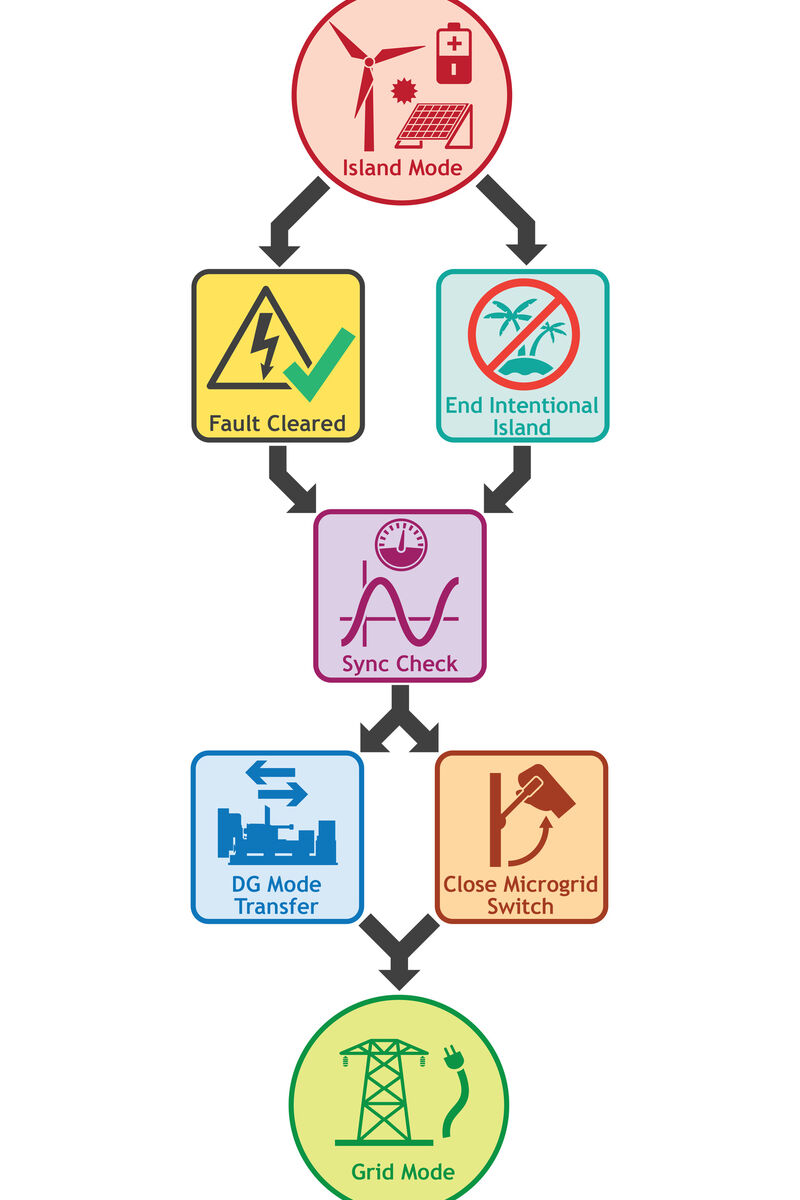
Developing a microgrid system topology and operations
As the development of a microgrid concept advances, it is critical to identify various possible operational modes of the system. Given the complexity of the system being analyzed, the number of possible system configurations is substantial. To fully understand the intricacies of each configuration or mode and the transition between them, a matrix of generation and load configurations should be developed. State diagrams provide a clear snapshot of each operating mode. Using transitional and fault clearing analyses, the design engineer can identify the required safeties, communications, and sequences of operations required for operation.
Potential modes of microgrid operation include:
- Grid connected/paralleled
- Grid disconnected/islanded
- Load shed
- Emergency
- Power purchase only
- Power purchase and self-generation
- Power export
- Micro-renewable generation
- Multiple vs single utility feed
- Varying self-generation dispatch
- Storage dispatch

Island- to Grid-Mode Operations (Illustration: Kyla Vana / Affiliated Engineers, Inc.)
A number of events can affect microgrid operations. Anomalies that need to be investigated and planned for include:
- Utility loss
- Generation asset loss
- Transformer loss
- Feeder loss
- Switching node loss
- Momentary utility voltage sag/brown-out
- Utility under-frequency event
- Momentary utility loss
- Sustained utility loss
- Fuel interruption
- Resynchronization to utility
Distributed generation (DG) that comprises a microgrid allows any for combination of local fuel-based or renewable energy sources (e.g., natural gas generators, microturbines, fuel cells, solar photovoltaic (PV) distributed wind, and combined heat and power “cogeneration” systems) to serve the loads of a facility, campus, city, or other defined district. Most often “greener” than the power produced by a traditional central power plant, DG is more efficient in transmission to its nearby served loads.
Implementation of 15MW on-site combined heat and power (CHP) plant to supplement outside electrical utilities was a central component of AEI’s approach to strengthening utility systems at the University of Texas Medical Branch (UTMB) in Galveston in the aftermath of Hurricane Ike. Several years later, in August 2017, Hurricane Harvey tested the system and the campus’ two CHPs, which ran safely, keeping all the research buildings open and avoiding catastrophic damage.
The extent of renewable energies such as solar PV or wind turbines connected to the grid is increasing, but production from these renewable technologies is subject to weather conditions. When the renewable source is not producing energy, the utility, local fuel-based generation assets, or stored energy must be available to carry the load. As more and more DG sources connect to the grid and supply power, multiple forms of storage will be needed to ensure that loads can be served reliably at any time. Options for energy storage continue to evolve.

Microgrid Illustration by Affiliated Engineers, Inc. Michael Schrader
As an industry, numerous technologies, such as batteries, hydrogen storage, and fuel cells have been evaluated. Advanced battery technologies and an increasing number of market-ready solutions are making battery storage a first-choice option. As smart buildings and even smart vehicles interconnect with the grid, they may be able to store and return power in the future.
Smart buildings can improve the operation of a microgrid that they are connected to. As load centers in a given locality, buildings that are technologically able to monitor their own energy consumption can be further designed to reschedule certain power usage to off-peak hours, improving the overall efficiency of a microgrid. These “intelligent” buildings can also monitor and adjust building performance to reduce load and bolster cost savings.
Portions of this article first appeared in the December 12, 2016 issue of Consulting-Specifying Engineer Magazine.